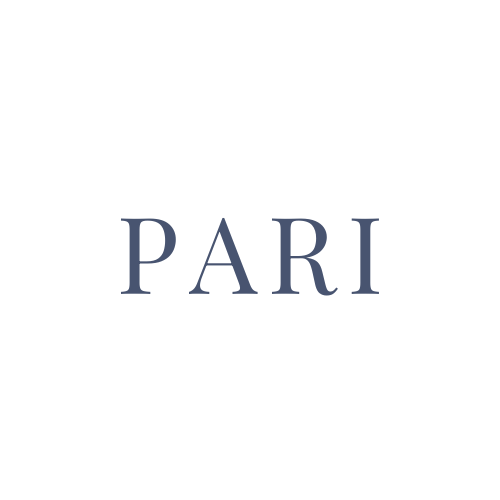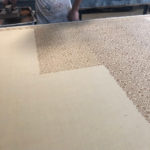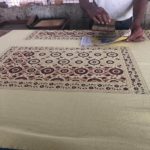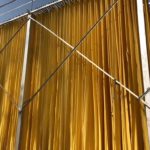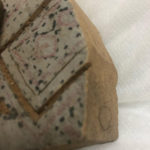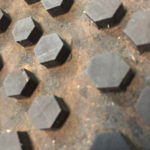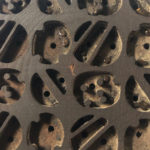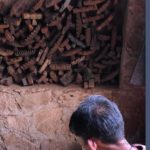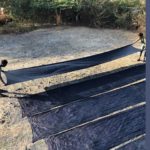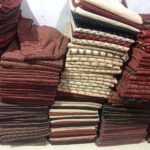Wood block printing is a technique used to print textiles with patterns or designs. This printing method has been widely used across Asia to print both textiles and paper. In India, block printing is believed to have been used since the 12th century. It is said that at that time these intricately printed fabrics were used by royalty. This traditional printing technique is still carried on by skilled Artisans across India.
We have visited many small family-run workshops in Rajasthan and Gujarat that continue these traditional printing methods. Each area has a printing method that is unique to that location. In Jaipur and surrounds you will find a lot of Sanganeri, Dabu, Jaal and Bagru prints, while in Western Rajasthan and Gujarat you will see a lot of the Sindh influenced Ajrakh prints. Throughout India you will find other printing styles such as Butti, Batik, Bagh, Kalamkari and many more.
The wood blocks used to print on the fabrics are carved with intricate patterns by highly skilled block makers. The block makers know the right type of wood to use, and how to expertly carve the blocks so that the printing pattern is even. The carving is done by hand drills, small chisels and other needle-like tools. The wood used was traditionally teak or sheesham but other woods are used now. The wood is seasoned and often soaked in oil. Oil is also used to clean and protect the blocks after use.
More than one wood block may be needed to get the desired pattern. These are referred to as outline block and filling blocks. The blocks also have registration points so that the printer can align each print up on the fabric, particularly if multiple blocks are being used to apply different layers of dye.
The 3 main printing techniques are discharge, direct block printing or resist printing.
- Discharge printing is where fabric is died and a chemical is used to remove some of the die to make a pattern.
- Direct block printing is where wood blocks are used to apply different layers of dye to plain fabric. They may use one or multiple designs and colours to build up the design.
- Resist printing uses a solution – often mud and resins – that is applied to the fabric using a wood block. Where this solution is applied the fabric will ‘resist’ any dye.
The printing process is extensive and some workshops such as those doing Ajrakh prints have over 20 steps they take to get their intricate designs.
- For some printing methods the fabric needs to be prepared first. The fabric is washed to remove any starch and also beaten to soften fibres. This preparation also involves soaking the fabric in solutions including sodium bicarbonate, limestone powder, fruit and plant extracts, resins, oils and yes – animal dung!
- Depending on the desired print the fabric may also be dyed at this stage as well.
- Once the fabric is prepared it is stretched over long tables. Wax or pins are used to secure the fabric flat onto the table.
- Then the block printing begins. The sequence used depends on the printing technique. This may include printing dark borders or patterns first, or the mud resist. Once these are dry they may be dyed in big dye vats. Fabrics that feature indigo dye may sit in the dye bath for 2 days. Others that are not to be completely dyed will be printed one or more times with the wood blocks to build up the pattern required.
- To print using the wooden blocks, they are dipped into the dye (or mud solution) and stamped onto the fabric.
- They will also go through multiple washing processes during the process in cold water and boiled, sometimes with other ingredients or dyes. They also beat the fabric against stone or concrete through the washing process also.
Printing has traditionally been done using natural ingredients and dyes that produce a more earthy, natural look. This is still the case for a lot of the more traditional workshops. Natural indigo is often a key colour in these prints. Now days you can get block prints in all colours using synthetic dyes. India’s textile industry has come a long way and most printers now use environmentally friendly, AZO free dyes.
Once printed the fabrics are dried outside in the sun hanging up on large racks or often outside on the ground. Sometimes you may find some small natural fires or even grass seeds on your fabric and these come from this natural drying process.
The fabrics are then folded up and stored for sale in what we refer to as Aladdin’s caves. These rooms are amazing to browse through to see all the amazing prints from each printing workshop.
We continue to support these small workshops and use the beautiful fabrics they make to ensure that these traditional arts can continue. You can check out our social media to see more pics and videos of this amazing process.
